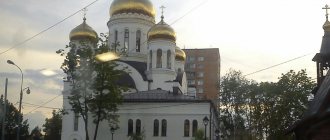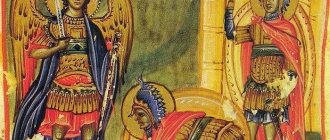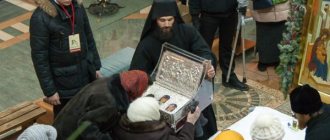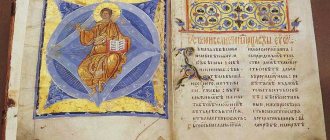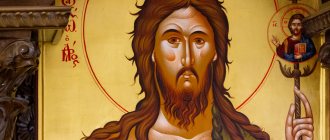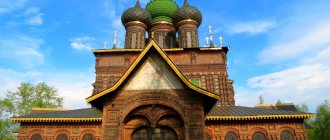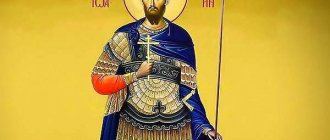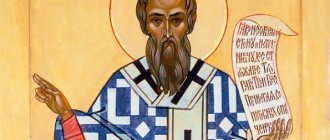The Orthodox righteous man was born on the territory of Little Russia and was raised in true piety. Having reached maturity, John entered service in the Russian army. In 1711, he, like most other soldiers, was captured by the Turks, who had an indescribable desire to convert Christians into Muslims. Blessed John was a slave for a long time in the service of his master, honestly fulfilling the duties assigned to him.
The saint showed great mercy and humility, helping even those who mocked him.
The Life of Saint Righteous John the Russian
Childhood and adolescence
Little is known about the saint’s early life. He was born in the south of Russia, in the countryside of Ruthenia, in 1690. His parents were Orthodox, pious people. They instilled in their son a love of virtues from childhood. Having matured, John was called up for military service in the army of Tsar Peter I Alekseevich.
Soldier's service and captivity
Ivan was just a soldier in the tsarist army, he served honestly, and took part in the Russian-Turkish war. In 1711, when the Prut campaign took place, John, like many Russian soldiers, was captured by the Tatars, who fought in alliance with the Turks. The young man was sent to Constantinople, where he was sold to Agha, who held the post of chief of the Turkish cavalry. The slave owner brought the Russian prisoner to Asia Minor, to his native settlement, located 12 hours away from Caesarea in Cappadocia.
Captivity of the Russian soldier John by the Tatars
As a result of the unsuccessful campaign of the Russian army, many Orthodox soldiers were captured by Muslims. The pagans made every effort to persuade the Russians to renounce Orthodoxy. Muslims do not need to join the ranks of fellow believers. For them, this is the evil joy of the fall of Orthodox people. Muslims remained contemptuous of those who converted to Islam, because those who converted were traitors.
To persuade the Russians to treason, Muslims used temptations and persuasion, and for the staunch soldiers of Christ they used torture and torment. Some could not stand the torment and converted to Islam. John loved Holy Orthodoxy and the Lord Jesus Christ, he was not afraid of any torment. He maintained Russian Orthodox loyalty.
Exploits in Turkish captivity
The Lord, for John’s faithfulness, softened the heart of his earthly master. Aga allowed John to remain faithful to Orthodoxy in exchange for good service as a slave in his house. The torment is over. A Russian prisoner was supposed to take care of the livestock and look after the stables. In its corner was the bed of a Russian confessor.
Aga and his wife took a liking to John and gave him the opportunity to change housing. But he chose to stay among the horses. The confessor did not notice the inconvenience and prayed at night, and the smell of horse manure disappeared, replaced by a fragrance. The ascetic ate only lean food.
John slept little, secretly went to the church of St. George, which was located not far from Aga’s home, and received Holy Communion. The Muslim's situation improved, and he understood that he owed his prosperity to the great Russian ascetic.
Having wealth, Agha decided to go to Mecca. His wife threw a feast to celebrate her husband's safe arrival at his destination. When serving pilaf, Aga’s favorite dish, to the guests, she noted that he would be happy with pilaf now. John, who humbly served at the table, said in response that the pilaf would go to Mecca to Aga. He took the dish with food and went to the stable. There, kneeling down, he prayed to the Lord, and the Lord showed a miracle - the pilaf went to Aga.
The guests did not believe John, believing that he either ate it himself or distributed it to poor people. But when Aga returned from the trip, he presented a dish he had brought from Mecca with pilaf on it. It appeared in his house on the table when Aga himself was absent and the front door was locked.
This news quickly spread around the area. John began to be loved and revered, people feared and respected the righteous man. The owners continued to insist on his moving from the stable, but the saint did not succumb to persuasion, continuing to strictly fast and carry the cross of asceticism.
The Life of John the Russian is an example of the perseverance and strength of the Russian spirit
Last years of life and death
Saint John suffered a serious illness and he, feeling that the hour of separation from his body was approaching, asked to begin Holy Communion. The priest, fearing the reaction of the Turks, did not openly carry the Holy Gifts, but hid them in an apple. Having begun the great sacrament, Righteous John departed to the Lord at the end of May 1730. Despite the fact that Islam was widespread in the area, the confessor was buried in Christian traditions.
People soon began to especially honor the saint and testified to the healings taking place at his grave. Help was received by both Orthodox Christians and people susceptible to the heresies of Armenianism and Protestantism.
John's childhood
On the icons the saint is depicted as a young, handsome youth. His life is so interesting and fascinating that it is more like a fairy tale. Nevertheless, all the events in his life happened in reality. The saint lived a short but instructive life, giving all Orthodox people a worthy example of faith and perseverance.
Origin and birth
John was born in Little Russia in 1690. In those days, the Zaporozhye Army was located on this land. During this period, Little Russia was mainly referred to as the left bank of Ukraine and Kyiv, which belonged to the Russian Empire. The right bank of the Dnieper remained part of the possessions of the Polish-Lithuanian Commonwealth.
It was not an easy time for the inhabitants of the country. In addition to the popular uprisings that took place at the beginning of Mazepa’s hetmanship, drought and pestilence hit the residents. Some Cossacks went over to the side of the Polish army. King Sigismund was pleased with this, knowing and appreciating the fighting abilities of the Zaporozhye Cossacks. Many of them died in the war, leaving families without breadwinners in Ukrainian settlements.
John came from the common people, so he was familiar with all the needs and troubles of this environment. From an early age he saw the suffering of his native land and was imbued with love for it. But God was pleased to tear him away from his homeland in order to help the inhabitants of other countries. There is no doubt that he remembered his beloved homeland until the end of his life and yearned for it.
Family
History has not preserved information about John's parents. However, it is known that they raised their child in the Christian faith and fear of God.
In Little Russian families, raising children was slightly different from Russian ones. For example, in Ukraine it is still customary to call parents “you” with respect. Ukrainian mothers were more emotional than Russians and communicated with their children in a raised voice. This was considered the norm. Little Russian women treated their children very kindly, but if they disobeyed, the child faced a rather serious punishment.
Particular attention has always been paid to the Christian upbringing of children. Strictness was applied to them in fulfilling church regulations. Even babies who had just been torn from their mother's breast were forced to fast and were not given milk.
The level of education in Little Russia in those years was higher than in Russia, thanks to Byzantine and Polish influence. Constantinople patronized the creation of fraternal schools, which accepted children of all classes.
Veneration of Saint John the Russian
The Holy Orthodox Church established the day of remembrance of the holy confessor on May 27.
The saint is especially revered on Mount Athos in the Russian monastery, where part of his incorruptible relics is located. In Russia, the first church in honor of the holy confessor was built in 2003 in Moscow. The construction was blessed by Patriarch Alexy II. Temples in honor of the saint stand in different cities of Russia and Ukraine. On the icon the confessor is depicted with a cross in his hand. People resort to his help in various everyday needs.
Temple in Sumy, Ukraine
Temple at Neo Prokopion, Greece
Small temple-chapel in Kuntsevo
Veneration and significance in Orthodoxy
John the Russian earned deep lifetime respect and veneration not only from the Orthodox, but also from people of other faiths. The saint not only did not renounce the faith of his fathers, but throughout his life he set an example for all local Orthodox Christians and other captives.
The church honors St. John for setting an example of perseverance, unshakable faith in the Lord, humility and fortitude. The saint often repeated the words “Nothing can separate me from the love of Christ: neither sorrow, nor torment, nor fire...”. The Russian soldier carried Christ in his heart, observed Orthodox rituals, led a righteous life, which earned him the grace of God. In 1962, the Russian Orthodox Church was canonized in the person of the righteous; churches were built in honor of the saint in Russia and Ukraine. Memorial Day of John the Russian - June 9.
Transfer of holy relics to Greece
In 1733, Saint John came in a dream to the priest from whom he received communion and spoke about the incorruptibility of his relics. The confessor’s words were confirmed by the illumination of the grave of Righteous John with an unearthly radiance. After opening the grave, a miracle was discovered - the relics remained incorrupt and fragrant. They were placed in the Church of St. George.
Righteous John did not allow his relics to be divided. Those who secretly took a piece of the relics were threatened by the saint, and they had to be returned. A temple was erected in Prokopion in honor of the holy confessor, to which monks from the Russian monastery on Athos donated funds. In gratitude, part of the saint’s relics, the right hand, was given to the Athonites and transferred to Holy Athos. John the Russian himself did not prevent this.
Iconography
According to Orthodox tradition, icon painters paint John as a handsome young man. They are usually depicted as a prisoner in poor clothes. On life-size icons the saint is depicted barefoot to remind of his slavery and captivity. Pictures from his life are often depicted around the saint.
The life of the saint was short, which is why in Greek and Russian icons John is always young. In his hands he holds a cross, a scroll of Holy Scripture, sometimes his hand is raised in a gesture of blessing of the Orthodox. On some icons John is depicted in purple, in the splendor and grandeur of holiness.
Miracle-working relics
In 1832, when Ibrahim Pasha revolted against the Turkish Sultan and the enemy entered Prokopion, the city was plundered. Not finding jewelry in the tomb of the confessor John, the soldiers threw the incorruptible relics out of the temple in order to desecrate the Christian shrine and burn them. While they were making a fire, the relics disappeared and ended up back in the temple. They were taken out again and placed on the fire, which did not harm them. At that moment they saw Saint John himself, standing in the fire and threatening his detractors. The soldiers got scared and fled without taking the looted valuables. The holy relics were not damaged by the flame, but only became blacker from the burning, but retained their fragrance.
The relics of the saint are in the Russian Monastery (Mount Athos)
Adulthood and last years of life
Hard work and exploits were not in vain and had a negative impact on Ivan’s health. He became seriously ill as soon as he crossed the threshold of his fortieth birthday. Feeling his death approaching, he ordered a clergyman to be sent to the nearest church to receive communion. But he was afraid to come openly to the Muslim’s house, handing over the Holy Gifts in an apple. John took communion and quietly departed to the Lord. This happened on May 27, old style, 1730.
The blessed one was buried according to Christian custom, despite the widespread prevalence of Islam in Turkish settlements. When the owner received the news that his servant John had died, the aga called the Christian priests and handed over the body to them for burial.
Prayer to Righteous John the Russian
Oh, holy newly-minted servant of God, John the Russian! Having fought a good fight on earth, you have received in heaven the crown of righteousness, which the Lord has prepared for all who love Him. In the same way, looking at your holy image, we rejoice at the glorious end of your life and honor your holy memory. You, standing before the Throne of God, accept our prayers, servant of God (names), and bring them to the All-Merciful God, to forgive us every sin and help us against the wiles of the devil, so that we may be delivered from sorrows, illnesses, troubles and misfortunes and all evil Let us live piously and righteously in this present world and through your intercession we will be worthy, even though we are unworthy, to see good things on the land of the living, glorifying the One in His saints, glorifying God, the Father and the Son and the Holy Spirit, now and forever.
Saint John is an example for everyone in humility and fidelity to Holy Orthodoxy. He helps everyone who comes to him with sincere faith.
If you find an error, please select a piece of text and press Ctrl+Enter.
What do they ask for before the image?
The saint became famous for his selfless help to his friends in misfortune, destitute and humiliated prisoners like himself. His master Aga was confident that he had achieved wealth thanks to John’s prayers. The saint helps everyone; you can turn to him in various needs and adversities. Before the image they ask:
- about strengthening in faith, getting rid of doubts;
- about giving health, healing;
- protect from strife, hostility, strengthen interethnic, religious unity, friendship;
- find peace of mind, forgive offenders, enemies, ill-wishers;
- help in difficult matters and worries.
Prayer before the image helps in protection from natural disasters, catastrophes, as well as in resolving family troubles and illnesses of children. The saint turns his prayers to the Almighty and asks for everyone who hopes for his help.
Prayer for work
O all-blessed confessor of Christ and great wonderworker John, treasure of Euboea, praise to the Greek country and kinsman of the Russian people! In the Hagarian captivity, you firmly endured the cruel beatings and burning of hair for Christ, but with your piety, the deeds and miracles of the faithful, you greatly strengthened you, you softened the unfaithful and enlightened them, and after your death you shone with countless miracles and healings. We, O servant of God, have such great boldness towards the Lord, but we, the needy, have such warm compassion, as we do not tolerate and see us in severe illnesses or severe sorrows, and for this reason, even those who are not called upon, quickly come, healing bodies and souls, casting out demons , converting those who have gone astray, and especially driving away all illness and sorrow from small children. Behold, even now our sins are burdensome and our souls have been worn away by debilitating sorrows, our bodily strength has become impoverished, and how can we resist despondency and more painful sadness, if not you yourself, the Holy One of God, rise up for us and take up arms against our enemies with grace! Ask, with your prayers favorable to the Lord, for those suffering from bodily ailments, complete healing, and for all, saving patience and gratitude; turn away sorrows, demonic slander and temptations; However, as much as the Lord allows, teach us to bear it wisely for cleansing; But enlighten us in the darkness of ignorance and oblivion of God’s existing commandments, instruct us to unswervingly do the will of God, resolve spiritual infertility, grant purification, sanctification and enlightenment to our souls; May we, together with you, glorify the All-Good God and the Most Pure Mother of God through your all-powerful intercession forever and ever. Amen.
Miracles of the Saint
Saint John from Russia is highly revered by the Greeks, and not only. Locals talk about numerous miracles associated with the relics. Every year they are re-dressed and their shoes are changed. But every time the slippers turn out to be worn out to holes. This indicates that the saint rises from his shrine and walks a lot on earth, helping people. He has been seen several times on the island, rushing to the aid of those who call him.
Shipwreck
In 1978, a Greek ship was sailing in one of the northern seas. Suddenly a terrible storm began. The waves tossed the ship like a toy from side to side, threatening to flood it with water and turn it upside down. The ship's control system has failed. In this critical situation, there was nothing left to do but trust in God’s help.
The captain called on the sailors to hold on and trust in God, and he himself went to the ship’s chapel. Until the morning, at the icon of St. John from Russia, he prayed with tears and asked not to leave the team to die for the sake of the children and wives who were waiting for their husbands at home.
At dawn the captain fell asleep, and when he woke up, he noticed that the storm and storm had subsided. Coming out on deck, he was surprised to see that their ship was docked in the port of Rotterdam. Who else but Saint John, to whom the captain prayed, helped them escape from death and brought the ship safely to the port.
Leaving the ship for repairs, the captain went to Greece. Here he venerated the relics of the saint. The captain brought with him golden vessels, which he presented to the temple as a token of gratitude for the rescue.
Memory of Healing
Near the reliquary with the relics of the saint, among the various jewelry left as a sign of gratitude, you can see a simple stick. In fact, this is a memory of the miraculous healing that occurred through prayers to St. John. In the 70s, a hunched over old woman was brought to the relics. She had been unable to straighten up for almost twenty years due to a serious illness.
The old woman, venerating the relics, tearfully prayed to the saint for healing. As a result, a miracle happened - she was able to straighten up completely and walk normally without experiencing pain. In honor of this event, a thanksgiving prayer service was served in the church, at which everyone shed tears of tenderness. As it was unnecessary, the servant of God left her stick at the shrine in memory of her recovery.
Doctor's cure
In 1964, local newspapers published an article about a miracle performed by St. John. A doctor who considered himself an atheist became seriously ill. During the examination, he was given a disappointing diagnosis: rectal cancer. Colleagues did not hide the fact that the disease was advanced, in the last stage.
Lying in the hospital, the doctor was left alone and could only turn for help to God, in whom he rejected faith. Unexpectedly for himself, he suddenly began to pray, saying that he had been an unbeliever all his life, but now he repented of his former atheism. The doctor asked St. John for healing, if possible.
Suddenly, after these words, an unfamiliar young doctor of good appearance entered the room and asked him about his well-being:
“I’m dying, how can I feel,” the patient said in despair.
- No, you won't die. “I took your illness upon myself,” the young doctor said joyfully and left the room.
The surprised patient followed him, but there was no strange visitor in the corridor, and no one saw him. Repeated examination showed that the patient is completely healthy. The healed man sent a letter to the bishop with two medical records (one says that he has cancer, the other says he is completely healthy) and evidence that he was honored to see the saint and through prayer to him was healed.
Healing children
St. John, according to the Savior’s commandment, loves children. Many of his miracles are associated with their healing.
Cure from leukemia
One woman had both children suffering from leukemia. It became increasingly difficult for the mother to watch her children fade away. Then the woman fervently prayed to St. John. In the morning, she noticed that the children’s appearance had changed, their cheeks were pink. The mother asked the doctor to do a blood test, and to everyone’s surprise, the results were within normal limits. Then the parents ordered two full-length wax figures of their children and delivered them to the shrine as a token of gratitude.
Healing a baby
A three-month-old baby was dying of leukemia. Doctors did not give any hope to the parents and said that they would be able to have more children. Father and mother prayed with all their hearts to St. John, and a miracle happened. The baby pointed to the icon. There everyone saw, like lightning, the image of a saint entering the wall. After this, the child became completely healthy.
Leg paralysis
The boy suffered from paralysis of his legs from birth. One day in the hospital he was sleeping, his mother was sitting next to him and praying to St. John. The kid had a dream in which a handsome rider rode up on a horse and offered his hand, inviting him to sit in the saddle.
The boy replied that he could not, because he was paralyzed. Then the horseman said that he was John from Russia, and that God had sent him to heal the sick. The saint invited him to stand on his feet. The boy woke up and called his mother: “Hold me, mom, Saint John from Russia ordered me to walk.” After that, he got up and walked on his own for the first time in his life.
Rare disease
One woman's child had a rare disease and could die at any minute. The mother and son were in a hospital in France. One day the baby developed a high fever. The mother suddenly grabbed her child and, running out of the hospital, in front of the surprised doctors, carried him to an Orthodox monastery, which was not far away.
She laid the boy next to the icon of the Most Holy Theotokos with the words: “If my baby needs to die, then let it happen here, in the temple in front of Your icon.” Hearing Greek speech (the woman was Greek), a Russian man who knew the language approached her and said: “In Greece there are the relics of St. John, my fellow countryman, who heals the sick." And he put the icon of the saint to the child’s forehead. The baby shuddered, the mother touched his forehead and noticed that the fever had passed. After this, the boy completely recovered.
Healing a disabled person
One baby was born with a deformity: his legs were turned towards his back. After the operation, doctors warned that the boy would never be able to stand on his feet due to the death of his nerves. The father prayed to St. John and went with his son to his relics. He also took a lamb with him to give it to the saint.
After holding the all-night vigil and prayer service, after the church closed, the father and the baby remained at the door. He fervently prayed to the saint. At night he said to his son: “Get up and bring me water.” The boy got up and walked on his own for the first time in his life. Everyone who saw this miracle cried. Since then, the young man comes annually with a lamb to the relics of the saint on the day of his recovery.
There are a great many similar cases of healing. Once, through the saint’s prayer, schoolchildren in the village of Urgup survived when the school building collapsed. The children hid under their desks, as if someone had warned them.
Life says that after captivity, Blessed John fell into slavery
After his captivity, Blessed John was sent to Constantinople. After which he was sold into slavery to one boss. The life of this leader says that he had the name or title “Aha.”
Aga brought the saint to his land, which was located in Asia Minor, in Cappadocia. Since John was an Orthodox man, he refused to convert to Islam. For this act he was humiliated by the Turks; they constantly tortured him.
But soon the firmness in his faith, meekness and hard work of the saint helped him gain respect from his master and household members. After which the bullying stopped.
John was no longer asked to convert to another faith. By order of his master, he began to work in the stables. He did all his work diligently. The other slaves laughed at him, but John took it completely without any malice.
Gradually, John was able to gain the love and trust of his master Aga. After which Aga invited John to live in a separate room and become free. But he refused. During the day he worked, observed fasts, and at night he went to the Church of St. George. He read prayers on the porch. Every Saturday he went to receive the Holy Mysteries of Christ.
During the journey, John's master was surprised by the miracle he performed
Soon his owner became one of the richest people. And this was due to the fact that a righteous man began to live in his house. Then Agha began to perform the Hajj. Hajj is a pilgrimage that involves visiting Mecca and its surrounding areas at a specific time.
During this trip, the owner's wife began inviting all his relatives and friends for dinner. A dish of pilaf was served as lunch. This was the owner's favorite dish. Then the saint, having tasted the pilaf, asked to be sent to Mecca. This request was fulfilled, but they thought that John decided to eat everything himself or give it to the poor.
Aga was surprised at the miracle that John performed. In the room he saw steaming pilaf, on which the name of his owner was engraved. Photo: prodromos.by
When Aga returned, he began to tell everyone about the miracle that happened to him. When he was in Mecca, he saw that in the locked room where he was staying, he saw steaming pilaf on which his name was engraved. And also on all the dishes in this house.
Canons and akathists
A canon with irmos in the 2nd tone and a touching akathist was written to Righteous John, which describes events from the life of the saint, as well as many of his miracles. The canon and akathist include prayers that contain the most necessary petitions for the Christian soul.
Initially, the service to St. John and the prayer canon were written in Greek. The text from the early 20th century list from the Athos Panteleimon Monastery was then translated into Russian and published in 1967 in the journal of the Moscow Patriarchate.
Akathist is a special hymn of praise in honor of St. John. Consists of 25 songs, arranged in order of the letters of the Greek alphabet. The author of the work is unknown; in 2021, some amendments were made to its text, which were approved by the Holy Synod. Reading the akathist can be combined with the morning or evening rule, or carried out separately. The most important thing is sincere faith and deep reverence for the saint.
